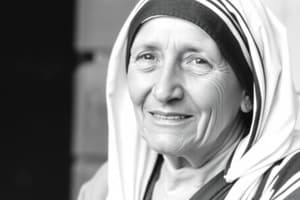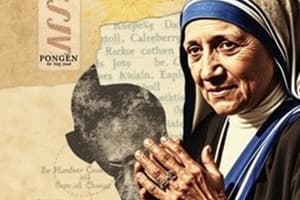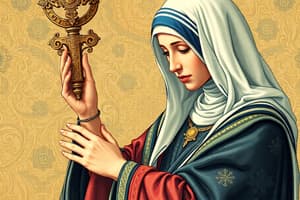Podcast
Questions and Answers
According to the provided content, what did Robert Lax tell Thomas Merton he should want to be?
According to the provided content, what did Robert Lax tell Thomas Merton he should want to be?
- A successful poet.
- A saint. (correct)
- A good Catholic.
- A wealthy writer.
What was Mother Teresa's primary goal throughout her life?
What was Mother Teresa's primary goal throughout her life?
- To gain recognition from the Vatican.
- To become a famous icon through photographs.
- To live a holy life and serve suffering humanity. (correct)
- To establish numerous Missionaries of Charity.
What physical features characterized Mother Teresa in her later years, as captured in photographs?
What physical features characterized Mother Teresa in her later years, as captured in photographs?
- A lined face, thick fingers, and misshapen feet. (correct)
- A radiant smile and well-fitted sandals.
- A youthful complexion and delicate hands.
- A somber expression and elegant attire.
What contrasting element remained constant in both the early and later photos of Anjezë Gonxhe Bojaxhiu?
What contrasting element remained constant in both the early and later photos of Anjezë Gonxhe Bojaxhiu?
What concept did Henri Nouwen use to describe the surrender embraced by Christian mystics like St. Teresa of Avila?
What concept did Henri Nouwen use to describe the surrender embraced by Christian mystics like St. Teresa of Avila?
According to Mother Teresa, what clears one's spiritual vision to recognize others as lovable creatures?
According to Mother Teresa, what clears one's spiritual vision to recognize others as lovable creatures?
What did Mother Teresa say was the key to sustaining love in action?
What did Mother Teresa say was the key to sustaining love in action?
What political stance did Nikola, Anjezë's father, advocate for after Skopje remained in Serbian territory?
What political stance did Nikola, Anjezë's father, advocate for after Skopje remained in Serbian territory?
What lesson did Drana, Mother Teresa's mother, teach her children about sharing?
What lesson did Drana, Mother Teresa's mother, teach her children about sharing?
Why did Drana take Anjezë and her children on an annual pilgrimage to the chapel of Our Lady of the Black Mountain?
Why did Drana take Anjezë and her children on an annual pilgrimage to the chapel of Our Lady of the Black Mountain?
What did Anjeze initially decide about her call to a religious life during her mid-teens?
What did Anjeze initially decide about her call to a religious life during her mid-teens?
Why did Drana initially try to dissuade Anjezë from becoming a missionary?
Why did Drana initially try to dissuade Anjezë from becoming a missionary?
Why was Anjezë's brother, Lazar, against her joining a religious order?
Why was Anjezë's brother, Lazar, against her joining a religious order?
Before embarking for India, what did Anjeze do to prepare for her missionary work?
Before embarking for India, what did Anjeze do to prepare for her missionary work?
What was the state of India when Anjeze arrived to begin her missionary work?
What was the state of India when Anjeze arrived to begin her missionary work?
What new religious name did Anjeze settle on for her religious life?
What new religious name did Anjeze settle on for her religious life?
What motivated Teresa to choose her new religious name?
What motivated Teresa to choose her new religious name?
What did Teresa become convinced of, especially after she left the Sisters of Loreto?
What did Teresa become convinced of, especially after she left the Sisters of Loreto?
What was unique about the people who lived in the Entally neighborhood of Calcutta, where Teresa worked after her initial vows?
What was unique about the people who lived in the Entally neighborhood of Calcutta, where Teresa worked after her initial vows?
What event during World War II significantly disrupted Teresa's life behind the walls of the Loreto compound?
What event during World War II significantly disrupted Teresa's life behind the walls of the Loreto compound?
What private vow did Mother Teresa make during the time of hardship and famine during World War II?
What private vow did Mother Teresa make during the time of hardship and famine during World War II?
What did Mother Teresa experience on September 10, 1946, on the train ride to Darjeeling?
What did Mother Teresa experience on September 10, 1946, on the train ride to Darjeeling?
What specific request did the archbishop of Calcutta insist that Teresa include in her application to leave the Loreto Sisters?
What specific request did the archbishop of Calcutta insist that Teresa include in her application to leave the Loreto Sisters?
What did Teresa decide she needed to learn to help the Dalits she would be serving?
What did Teresa decide she needed to learn to help the Dalits she would be serving?
What does "Motijhil", the area where Teresa decided to make her home after her crash course in first aid, mean?
What does "Motijhil", the area where Teresa decided to make her home after her crash course in first aid, mean?
In the early months of her new ministry, what new observation did Mother Teresa make about the poor?
In the early months of her new ministry, what new observation did Mother Teresa make about the poor?
What made Teresa's ministry's beginnings difficult in Motijhil and other areas?
What made Teresa's ministry's beginnings difficult in Motijhil and other areas?
What did Mother Teresa do because she thought that God had begun to bless the work?
What did Mother Teresa do because she thought that God had begun to bless the work?
What belief about serving did not apply to what the Missionaries of Charity do?
What belief about serving did not apply to what the Missionaries of Charity do?
Why did journalist Malcom Muggeridge interview Mother Teresa?
Why did journalist Malcom Muggeridge interview Mother Teresa?
After he became famous, in what situation had Christopher Hitchens attacked Mother Teresa and the Missionaries of Charity?
After he became famous, in what situation had Christopher Hitchens attacked Mother Teresa and the Missionaries of Charity?
Besides physical suffering, what kind of suffering did the Mother Teresa and her Sisters try to alleviate?
Besides physical suffering, what kind of suffering did the Mother Teresa and her Sisters try to alleviate?
Why it was strange or unexpected that she and the those she helped were transported to a grave with an instrument of war?
Why it was strange or unexpected that she and the those she helped were transported to a grave with an instrument of war?
What quality had people noticed in Saint Teresa and the women of action in terms of love?
What quality had people noticed in Saint Teresa and the women of action in terms of love?
To whom did each person say he / she would devote to as told at Teresa's Nobel Peace Prize?
To whom did each person say he / she would devote to as told at Teresa's Nobel Peace Prize?
Why did Pope John Paul II turn to Mother Teresa in 1982?
Why did Pope John Paul II turn to Mother Teresa in 1982?
Because they were told no to assist for fear that they may die from closeness with the one they were helping, what was one of the areas where she had to advocate hard for acceptance?
Because they were told no to assist for fear that they may die from closeness with the one they were helping, what was one of the areas where she had to advocate hard for acceptance?
Flashcards
Deepest Heartfelt Desire
Deepest Heartfelt Desire
The desire to grow more saintly/holy and develop a closer relationship with God.
Sisters of Loreto
Sisters of Loreto
Religious sisters who dedicate life to educating young people, founded by Venerable Mary Ward.
Downward mobility
Downward mobility
An acceptance of what comes our way and letting go of bitterness or disappointment.
“I want to be holy”
“I want to be holy”
Signup and view all the flashcards
The third step to holiness
The third step to holiness
Signup and view all the flashcards
Dalits
Dalits
Signup and view all the flashcards
Motijhil
Motijhil
Signup and view all the flashcards
spiritual consolation.
spiritual consolation.
Signup and view all the flashcards
Seeking permission quickly.
Seeking permission quickly.
Signup and view all the flashcards
Seeking permission help.
Seeking permission help.
Signup and view all the flashcards
The Devil
The Devil
Signup and view all the flashcards
Jesus's "I thirst"
Jesus's "I thirst"
Signup and view all the flashcards
Archbishop Périer
Archbishop Périer
Signup and view all the flashcards
Subhasini Das
Subhasini Das
Signup and view all the flashcards
Fyodor Dostoevsky
Fyodor Dostoevsky
Signup and view all the flashcards
Took final vows
Took final vows
Signup and view all the flashcards
Found the divine call
Found the divine call
Signup and view all the flashcards
Love begins at home
Love begins at home
Signup and view all the flashcards
Cannot justify abortion
Cannot justify abortion
Signup and view all the flashcards
Little way in life of others.
Little way in life of others.
Signup and view all the flashcards
Mother Teresa’s suffering
Mother Teresa’s suffering
Signup and view all the flashcards
The Simple path
The Simple path
Signup and view all the flashcards
Establishment follow pattern
Establishment follow pattern
Signup and view all the flashcards
Visiting Kalighat
Visiting Kalighat
Signup and view all the flashcards
The Archbishop’s support
The Archbishop’s support
Signup and view all the flashcards
When there all linked
When there all linked
Signup and view all the flashcards
Study Notes
Becoming Holy
- Thomas Merton and Robert Lax spoke about sainthood shortly after Merton's conversion to Christianity where Lax stated one must want to be a saint to become one.
- The deepest desire is to grow in holiness and enter a relationship with God.
- Other desires are expressions of this wellspring.
- Mother Teresa, known as the "saint of the gutters" or "saint of the slums," recognized her desire for holiness from a young age.
- This desire for holiness remained with her throughout her life, with her goal being to live a holy life, pleasing God and serving humanity.
- Her holiness was so evident that admirers advocated for her canonization after she died on September 5, 1997.
- Pope John Paul II beatified her in October 2003 and believed she was an icon of the Good Samaritan.
- Pope Francis declared her a saint on September 4, 2016, naming her St. Teresa of Calcutta.
- Mother Teresa, a diminutive nun was always captured in thousands of iconic photographs.
- Mother Teresa always appeared dressing the same, in the white sari with blue trim, the habit of the Missionaries of Charity who she founded then led for nearly a half-century.
- She wore a blue-bordered scarf covers her head and brow, and a small crucifix pinned on her left shoulder, next to her heart.
- Teresa's face was incredibly lined, she began to look older even in middle-age.
- Her fingers were thick and blunted from years of scrubbing floors and toilets, and her hands' wrinkled skin looked like elephant hide.
- Her feet were small, with toes almost grotesquely misshapen from wearing ill-fitting and secondhand sandals, she was barely 4 feet, 11 inches tall.
- Age and labor bent her back, sometimes looking bent double, expression showing somber or laughing.
Anjezë’s Eyes
- Only a few sepia-colored photographs exist of Anjezë Gonxhe Bojaxhiu, before becoming Mother Teresa of the Missionaries of Charity.
- In one photo, she poses with friends holding an open umbrella, and in another, taken before leaving for India, she stares pensively at the camera, looking at her future.
- These 1920s photos reveal Anjezë had thick, dark hair and a high, graceful forehead, disappearing behind a veil when she became a nun.
- There was one unmistakable feature remained constant; her eyes, reflecting both joy and suffering.
- It's said the eyes had seen God and were alert for another glimpse of the Divine, even witnessing disease, poverty, starvation, scorn, and indifference.
- That holiness, living commitment to conforming to God's will to conform her human will, captivating the world.
- Examining Teresa's life, works, and spirituality teaches one how to grow into a birthright as creatures made in the likeness of God.
Divine Stirring
- St. Augustine said, “Fill yourself first [with God], and only then will you be able to give to others.”
- God’s “perfect will” was always for people to become holy, asking grace to fuel desires and efforts.
- There was part to play by surrendering to divine stirring, conforming to God’s will, and allowing Christ to live in everyone.
- As Mother Teresa counseled her Sisters, work isn't ours, so must not spoil it, it would be a great injustice to God because the work is his.”
- Henri Nouwen referred to this surrender as “downward mobility,” repudiating pride and ego to love God/fellow humans.
- Downward mobility meant rejecting economic success and worldly power with an inward withdrawal to discern God's stirrings in the deepest core.
- This surrender was achieved by not reading books or listening to words, but by accepting humiliations in a prayerful and grateful way, accepting what comes your way, and letting go of any bitterness/disappointment.
- "I want to be holy” meant divesting everything not of God, empty heart of material things with a renouncement of own will/inclinations/whims/fickleness as a generous slave to God.
- A conversation with Mother Teresa inspired Nouwen’s recommendation of downward mobility.
- She suggested spending one hour a day adoring the Lord and never doing anything wrong.
Steps to Holiness
- Becoming holy begins with willing to be holy by practicing self-emptying of downward mobility.
- Blessing, often taught in a simple way, like regular prayerful adoration of the Lord.
- Holiness becomes easier with profligate love after taking the first step, with emptying ourselves to allow recognizing our lovable brothers/sisters.
- The ability to notice and touch the wounds of humanity is gained because of no longer being enslaved by our egos, which breaks the heart of stone and replaces it with compassion.s
- Thomas Merton captured the new view of a world love brings while standing on a street corner.
- God became incarnate as a member of the human race, a liberation from an illusory difference with immense joy.
- There is no way of telling people that they are all walking around shining like the sun.
- She helped others see themselves as radiant carriers of God's likeness as an exercise through her entire life.
- Holiness follows naturally from love as we dedicate ourselves to a life of service with commitments stretching toward heaven to be like our heavenly Father.
- Action was sustained through learning to see Christ in everyone.
- When willingly undertaking works of mercy our love is shown to those we serve and cleave to Christ.
- Anjezë Gonxhe Bojaxhiu's luminous eyes and calm face had already intuited so much before becoming a nun, as what takes most people a lifetime to grasp was given to her when she was young.
- Her self-emptying love/service grew until she discerned her calling: service the poor of the slums.
- Eighty years can be traced in photos of her holy sainthood starting in her youth.
A Skopje Childhood
- Anjeze Gonxhe Bojaxhiu, the future Teresa of Calcutta's life from birth until she left home at eighteen, was set against the backdrop of war.
- Anjeze was born on August 26, 1910, in Skopje, Kosovo, a predominantly Serbian town in the crumbling Ottoman Empire.
- Before her birth, ethnic Albanians in Kosovo unsuccessfully bid for independence, followed by regional wars redrawing borders to creating an Albanian state
- In 1914, World War I destabilized the Balkans.
- Both of her parents were ethnic Albanians whom Mother Teresa remembered as being devoted to one another.
- Nikola, Anjezë's father, was an outspoken Albanian advocate and city councilor, earning respect and political enemies.
- In 1919, Nikola died suddenly with the suspicion being from poisoned by Serbian nationalists although was only forty-five.
Drana and her Faith
- Nikola's widow, Drana, and her three children, Anjeze (8), Lazar (11), and Aga (15), were left destitute.
- After Nikola's passing, Drana took in sewing/embroidery work to provide, telling her children to share what little they had with others.
- She taught her children "never to eat a single mouthful unless you are sharing it with others", with Drana "never allowed any of the poor people who came to our door to leave empty-handed.
- Drana's commitment to hospitality came from her deep faith, although most Albanians were either Orthodox or Muslim so the Bojaxhiu family was Roman Catholic.
- They had daily prayers at home, regularly attending Sacred Heart, along holy shrines.
- Lazar grumbled about his mother's/sisters' piety because they lived in involved with the choir, the religious services, the church.
- The women were involved in the parish choir, a natural outlet because the family women were musically talented.
- Anjeze chose the mandolin, had a good voice to sing solos during services, coddled as a baby "flower bud".
- Temperamentally, she was quiet and introspective, physical constitution was more of a concern for Drana than her shyness.
- Anjeze suffered from a persistent cough and periodic chills/fever of malaria given the Valley location with hot humid summers.
- To get Anjeze out of the valley, Drana took her children on annual pilgrimages to Our Lady of the Black Mountain in Letnica.
- The Madonna of Letnica interceded for her vocation on the feast of the Assumption where she prayed with a lighted candle and singing to decide to devote herself to God through religious life.
- Every Feast of the Assumption, Catholics venerate the Black Madonna at this shrine, where pilgrims walk miles in bare feet or pebbles as acts of penitence.
Guided to Call
- Like Drana, Anjeze’s faith grew, however, her real education was under the tutelage of Fr. Franjo Jambrekovic, assigned to Sacred Heart.
- He organized a club for girls as their spiritual director to center them on the Spiritual Exercises of Ignatius, founder of the Society of Jesus to practice daily examination of conscience.
- They were trained in the Ignatian technique of placing themselves in biblical scenes and think less abstractly about the faith, like the story of Feeding of the Five Thousand given her mother's insistence on feeding wayfarers.
- Anjeze judged people before discovering her vocation to the religious life during one of the pilgrimages with Fr. Jambrekovic
- Believing she had a calling to the poor, her frail health made her mother dissuade her so Anjeze tested her calling by waiting a few years.
- She continued her religious instruction, attending mass, in family prayers, and retreats.
- During her mid teens she relayed the Jesuits’ stories serving Christ while discovering her calling by through letter correspondence with Fr. Jambrekovic
Calling Discovered
- Mother Teresa recalled that the stories "used to give us the most beautiful descriptions about the experiences they had with the people, and especially the children, in India," as she found them excitingly exotic.
- Newspaper accounts might also sparked Anjeze's interest in India about barrister Mohandas Gandhi struggling against apartheid in South Africa.
- By eighteen, Anjeze sensed the vocation felt six years prior returned and that God called her to comfort the poor in foreign lands.
- Teresa said, "I've never doubted even for a second that I've done the right thing: it was the will of God by his choice", with God determining her destiny.
- Anjezë shared that she had a vocation and told her mother that she tried to dissuade with once again, possibly fearing she would never see her youngest daughter again, though her will was not dissuaded
- This turned out to be true, her only contact for the rest of her life was through the mail, often not arriving
- She gave Anjeze her blessing and also advised full dedication due to fear to keep God pleased.
- His youngest daughter to reconsider her plan that would come to do so.
- Drana wasn't the only member of the family who disapproved of Anjezë's vocation as Lazar’s letter and family’s “ ower bud” revealed the opposite
- Fr. Jambrekovic found Anjezë genuine to join the religious order and decided joining missionary nuns best suit her.
Loreto
- Fr. Jambrekovic recommended the Institute of the Blessed Virgin Mary, also called the Sisters of Loreto.
- Anjeze wrote to the Loreto Mother Superior requesting admission and expressing a desire to become one of them to work for Jesus to show sincerity and devotion and surrendering herself.
- As she received a positive reply she travelled 800km North to Zagreb for her formal interview
- The meeting lead to the acceptance of her postulants with another young girl.
- She attended six weeks at Dublin for a crash course in english.
- To become one she had to pass the death of her younger soul to become a missionary
- First had to first be self con fident of her call to God given that the family death had made him leave her home. fl
Studying That Suits You
Use AI to generate personalized quizzes and flashcards to suit your learning preferences.




